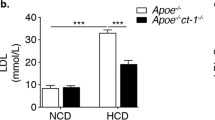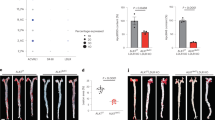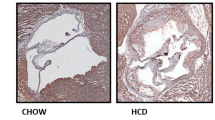Abstract
Inflammation is a major contributor to atherosclerosis by its effects on arterial wall biology and lipoprotein metabolism. Interleukin-10 (IL-10) is an anti-inflammatory cytokine that may modulate the atherosclerotic disease process. We investigated the effects of adeno-associated virus (AAV) vector-mediated gene transfer of IL-10 on atherogenesis in apolipoprotein E (ApoE)-deficient mice. A murine myoblast cell line, C2C12, transduced with AAV encoding murine IL-10 (AAV2-mIL10) secreted substantial amounts of IL-10 into conditioned medium. The production of monocyte chemoattractant protein-1 (MCP-1) by the murine macrophage cell line, J774, was significantly inhibited by conditioned medium from AAV2-mIL10-transduced C2C12 cells. ApoE-deficient mice were injected with AAV5-mIL10 into their anterior tibial muscle at 8 weeks of age. The expression of MCP-1 in the vascular wall of the ascending aorta and serum MCP-1 concentration were decreased in AAV5-mIL10-transduced mice compared with AAV5-LacZ-transduced mice. Oil red-O staining of the ascending aorta revealed that IL-10 gene transfer resulted in a 31% reduction in plaque surface area. Serum cholesterol concentrations were also significantly reduced in AAV5-mIL10-transduced mice. To understand the cholesterol-lowering mechanism of IL-10, we measured the cellular cholesterol level in HepG2 cells, resulting in its significant decrease by the addition of IL-10 in a dose-dependent manner. Furthermore, IL-10 suppressed HMG-CoA reductase expression in the HepG2 cells. These observations suggest that intramuscular injection of AAV5-mIL10 into ApoE-deficient mice inhibits atherogenesis through anti-inflammatory and cholesterol-lowering effects.
This is a preview of subscription content, access via your institution
Access options
Subscribe to this journal
Receive 12 print issues and online access
$259.00 per year
only $21.58 per issue
Buy this article
- Purchase on Springer Link
- Instant access to full article PDF
Prices may be subject to local taxes which are calculated during checkout








Similar content being viewed by others
References
The Scandinavian Simvastatin Survival Study Group. Randomised trial of cholesterol lowering in 4444 patients with coronary heart disease: the Scandinavian Simvastatin Survival Study (4S). Lancet 1994; 344: 1383–1389.
Shepherd J et al. Prevention of coronary heart disease with pravastatin in men with hypercholesterolemia. West of Scotland Coronary Prevention Study Group. N Engl J Med 1995; 333: 1301–1307.
Chen H, Ikeda U, Shimpo M, Shimada K . Direct effects of statins on cells primarily involved in atherosclerosis. Hypertens Res 2000; 23: 187–192.
Feingold KR, Grunfeld C . Role of cytokines in inducing hyperlipidemia. Diabetes 1992; 41 (Suppl 2): 97–101.
Fiorentino DF, Bond MW, Mosmann TR . Two types of mouse T helper cell. IV. Th2 clones secrete a factor that inhibits cytokine production by Th1 clones. J Exp Med 1989; 170: 2081–2095.
Uyemura K et al. Cross-regulatory roles of interleukin (IL)-12 and IL-10 in atherosclerosis. J Clin Invest 1996; 97: 2130–2138.
Mallat Z et al. Expression of interleukin-10 in advanced human atherosclerotic plaques: relation to inducible nitric oxide synthase expression and cell death. Arterioscler Thromb Vasc Biol 1999; 19: 611–616.
Pinderski Oslund LJ et al. Interleukin-10 blocks atherosclerotic events in vitro and in vivo. Arterioscler Thromb Vasc Biol 1999; 19: 2847–2853.
Mallat Z et al. Protective role of interleukin-10 in atherosclerosis. Circ Res 1999; 85: e17–e24.
Smith DA et al. Serum levels of the antiinflammatory cytokine interleukin-10 are decreased in patients with unstable angina. Circulation 2001; 104: 746–749.
Anguera I et al. Elevation of serum levels of the anti-inflammatory cytokine interleukin-10 and decreased risk of coronary events in patients with unstable angina. Am Heart J 2002; 144: 811–817.
van Exel E et al. Low production capacity of interleukin-10 associates with the metabolic syndrome and type 2 diabetes: the Leiden 85-Plus study. Diabetes 2002; 51: 1088–1092.
Von Der Thusen JH et al. Attenuation of atherogenesis by systemic and local adenovirus-mediated gene transfer of interleukin-10 in LDLr−/− mice. FASEB J 2001; 15: 2730–2732.
Kessler PD et al. Gene delivery to skeletal muscle results in sustained expression and systemic delivery of a therapeutic protein. Proc Natl Acad Sci USA 1996; 93: 14082–14087.
Duan D et al. Circular intermediates of recombinant adeno-associated virus have defined structural characteristics responsible for long-term episomal persistence in muscle tissue. J Virol 1998; 72: 8568–8577.
Bohl D et al. Improvement of erythropoiesis in beta-thalassemic mice by continuous erythropoietin delivery from muscle. Blood 2000; 95: 2793–2798.
Shimpo M et al. AAV-mediated VEGF gene transfer into skeletal muscle stimulates angiogenesis and improves blood flow in a rat hindlimb ischemia model. Cardiovasc Res 2002; 53: 993–1001.
Chao H et al. Several log increase in therapeutic transgene delivery by distinct adeno-associated viral serotype vectors. Mol Ther 2000; 2: 619–623.
Duan D et al. Enhancement of muscle gene delivery with pseudotyped adeno-associated virus type 5 correlates with myoblast differentiation. J Virol 2001; 75: 7662–7671.
Rabinowitz JE et al. Cross-packaging of a single adeno-associated virus (AAV) type 2 vector genome into multiple AAV serotypes enables transduction with broad specificity. J Virol 2002; 76: 791–801.
Yla-Herttuala S et al. Expression of monocyte chemoattractant protein 1 in macrophage-rich areas of human and rabbit atherosclerotic lesions. Proc Natl Acad Sci USA 1991; 88: 5252–5256.
Seino Y et al. Expression of monocyte chemoattractant protein-1 in vascular tissue. Cytokine 1995; 7: 575–579.
Nelken NA, Coughlin SR, Gordon D, Wilcox JN . Monocyte chemoattractant protein-1 in human atheromatous plaques. J Clin Invest 1991; 88: 1121–1127.
Gu L et al. Absence of monocyte chemoattractant protein-1 reduces atherosclerosis in low density lipoprotein receptor-deficient mice. Mol Cell 1998; 2: 275–281.
Boring L, Gosling J, Cleary M, Charo IF . Decreased lesion formation in CCR2−/− mice reveals a role for chemokines in the initiation of atherosclerosis. Nature 1998; 394: 894–897.
Rayner K, Van Eersel S, Groot PH, Reape TJ . Localisation of mRNA for JE/MCP-1 and its receptor CCR2 in atherosclerotic lesions of the ApoE knockout mouse. J Vasc Res 2000; 37: 93–102.
Mascaro C et al. Sterol regulatory element binding protein-mediated effect of fluvastatin on cytosolic 3-hydroxy-3-methylglutaryl-coenzyme A synthase transcription. Arch Biochem Biophys 2000; 374: 286–292.
Hardardottir I et al. Effects of TNF, IL-1, and the combination of both cytokines on cholesterol metabolism in Syrian hamsters. Lymphokine Cytokine Res 1994; 13: 161–166.
Matsushita T et al. Adeno-associated virus vectors can be efficiently produced without helper virus. Gene Therapy 1998; 5: 938–945.
Okada T et al. Development and characterization of an antisense-mediated prepackaging cell line for adeno-associated virus vector production. Biochem Biophys Res Commun 2001; 288: 62–68.
Chiorini JA, Kim F, Yang L, Kotin RM . Cloning and characterization of adeno-associated virus type 5. J Virol 1999; 73: 1309–1319.
Okada T et al. Adeno-associated viral vector-mediated gene therapy of ischemia-induced neuronal death. Methods Enzymol 2002; 346: 378–393.
Zhang SH, Reddick RL, Piedrahita JA, Maeda N . Spontaneous hypercholesterolemia and arterial lesions in mice lacking apolipoprotein E. Science 1992; 258: 468–471.
Ishibashi S et al. The two-receptor model of lipoprotein clearance: tests of the hypothesis in "knockout" mice lacking the low density lipoprotein receptor, apolipoprotein E, or both proteins. Proc Natl Acad Sci USA 1994; 91: 4431–4435.
Acknowledgements
We thank Dr John A Chiorini for providing pAAV5-RNL and pAAV5-RepCap (identical to 5RepCapB) and Avigen, Inc. (Alameda, CA, USA) for providing pAAV-LacZ, pHLP19, and pAdeno. We also thank Ms. Miyoko Mitsu for her encouragement and technical support. This study was supported in part by Research Grants from the Ministry of Education, Culture, Sports, Science and Technology; the Ministry of Health, Labor and Welfare; the Vehicle Racing Commemorative Foundation; and Mitsui Social Welfare Foundation.
Author information
Authors and Affiliations
Rights and permissions
About this article
Cite this article
Yoshioka, T., Okada, T., Maeda, Y. et al. Adeno-associated virus vector-mediated interleukin-10 gene transfer inhibits atherosclerosis in apolipoprotein E-deficient mice. Gene Ther 11, 1772–1779 (2004). https://doi.org/10.1038/sj.gt.3302348
Received:
Accepted:
Published:
Issue Date:
DOI: https://doi.org/10.1038/sj.gt.3302348
Keywords
This article is cited by
-
IL-10/STAT3 is reduced in childhood obesity with hypertriglyceridemia and is related to triglyceride level in diet-induced obese rats
BMC Endocrine Disorders (2018)
-
Adeno-associated Virus Vector-mediated Interleukin-10 Induction Prevents Vascular Inflammation in a Murine Model of Kawasaki Disease
Scientific Reports (2018)
-
NLRP3 Deficiency Reduces Macrophage Interleukin-10 Production and Enhances the Susceptibility to Doxorubicin-induced Cardiotoxicity
Scientific Reports (2016)
-
AAV2/8-humanFOXP3 gene therapy shows robust anti-atherosclerosis efficacy in LDLR-KO mice on high cholesterol diet
Journal of Translational Medicine (2015)
-
AAV-Mediated Gene Therapy for Atherosclerosis
Current Atherosclerosis Reports (2014)



